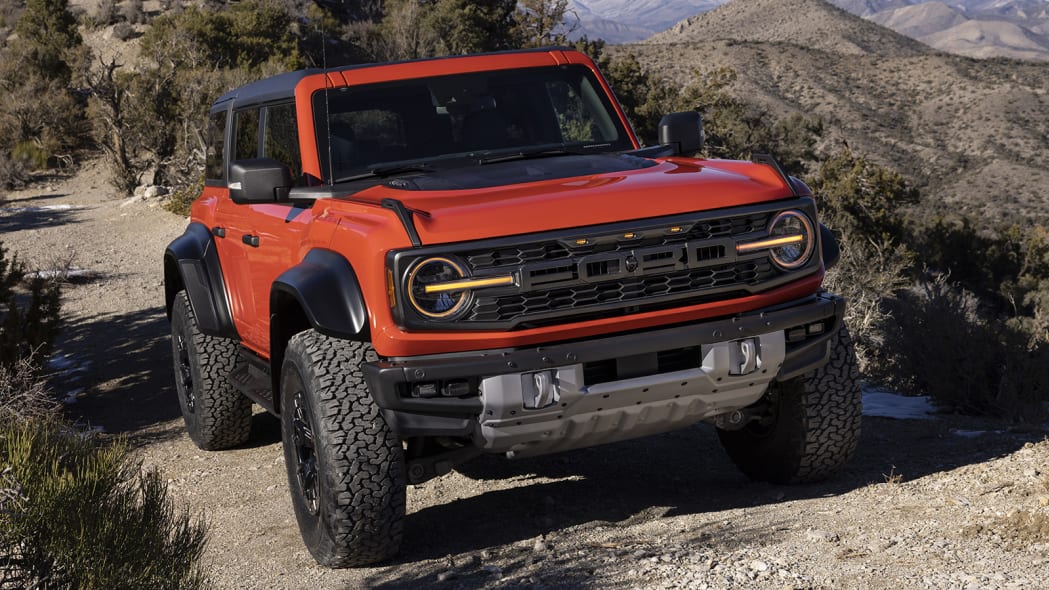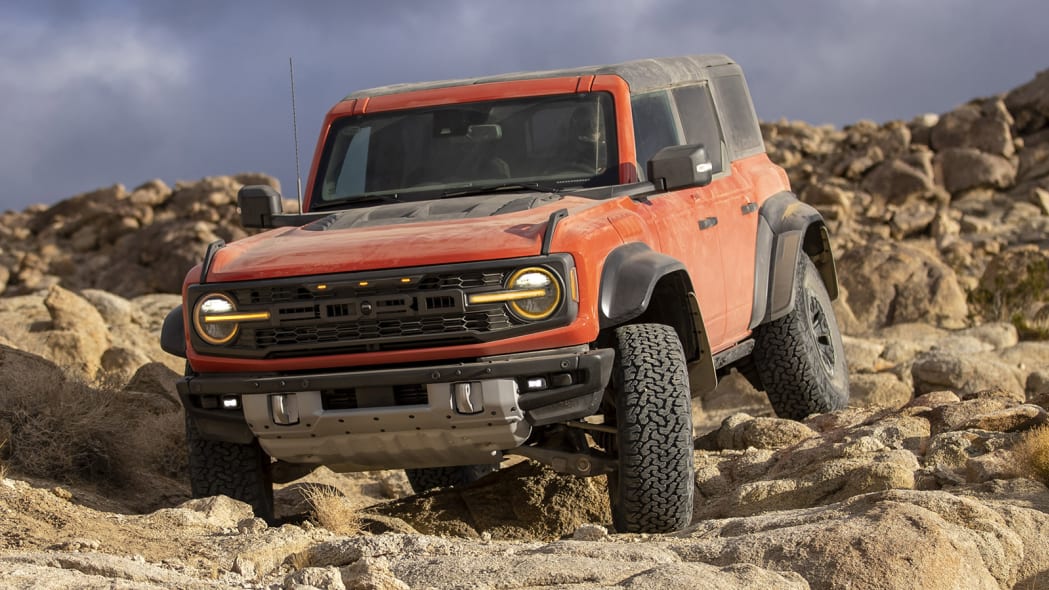Probably the first thing you'll notice about the Bronco Raptor is that it's wide. The track has been increased by 8.6 inches, a combination of suspension upgrades and the standard 37-inch tires. To accommodate the width, the actual fenders have been punched out a bit, losing some of the side character line, and the fender flares have been stretched. They have a more squared-off design
Up front gets the Raptor's signature grille with block "FORD" lettering and three of the five mandated lights for wide vehicles. The grille is opened up more for better cooling, too. Hood vents also contribute to that mission, while front fender vents help to reduce the build up of air pressure under the front end at speed. Under the nose is an even thicker skid plate than what's available on regular Broncos, along with full underbody protection for the engine, transmission, transfer case and fuel tank. The bumper also includes beefy tow hooks and Rigid Industries LED fog lights. The outer fogs are capped-off for road use because of lighting restrictions, but are quickly removed for off-road use
Rock rails now have steel side steps that are coated in a bedliner-style material. Understanding that there may be times they're a hindrance off road, Ford made them bolt-on units with outward-facing bolts. The factory tool kit includes the correct-size driver to remove them at a moment's notice. Even the mirrors get an update in the form of outboard marker lights required of wide road vehicles. You see orange ones from the front; red from the rear. The huge fenders feature rubber portions at the rear. Not only are these parts better able to resist damage from loose rocks, they're removable and replaceable, so you don't need a full fender replacement.
Around the back, you'll find a full-size 37-inch spare tire mounted to the swing gate, which has been reinforced with a magnesium bracket to handle the extra weight (we discovered the Raptor's 37-inch wheel/tires weigh in at a whopping 101.5 pounds each). The giant spare has also necessitated some lighting changes. The high-mount brake light sits higher, and incorporates the wide-vehicle lighting. The actual taillights are completely different, too, and have been styled to look a bit like the pod lights on professional racing trucks. The rear brake light hides a neat design touch in a backwards "Raptor" logo. This is so that it looks correct in the reflection of the rear glass, and in the rear-view mirrors.
Performance Upgrades
The Bronco Raptor, unsurprisingly, has a whole lot of changes under the skin to make it a monster off-roader. Ford went into great detail on some of those upgrades, and is waiting to say more on some of the others. Unfortunately, one of those things they're mum on is the powertrain. The company did reveal that the Bronco Raptor gets a twin-turbocharged 3.0-liter V6, so more displacement than the current top-rung 2.7-liter V6 that produces 315 horsepower. Ford says the Raptor will be good for more than 400, and that it's coupled to a unique variable exhaust. The drive modes include a new tow/haul mode and a Baja mode, the latter of which features an anti-lag system like that on the F-150 Raptor. It works by leaving exhaust valves open off-throttle to keep some air moving through and spinning the turbos for faster response. But that's all Ford will say for now about the engine. The Raptor does get a 10-speed automatic transmission, and the transfer case has heavier duty clutches.
As for what the chassis, the fully-boxed frame received some reinforcing braces, along with strong shock mounts and some new jounce bumpers all to handle hard impacts at high speeds. The front and rear axles are stronger, and the front control arms are larger and stronger. Even the steering rack and knuckles are tougher, all in the name of handling fast off-roading and the weight from the huge tires. The body also gets an aluminum brace across the roll bar near the B pillars and a carbon fiber brace above the cargo area that increase body rigidity by more than 50%.
The suspension itself is still independent front and solid rear with coil springs all around (you can read about the suspension of the Bronco Badlands with the Sasquatch package in our suspension deep dive). The Raptor uses Fox 3.1 LiveValve adaptive shocks, and the rears have external reservoirs. Electronic disconnecting sway bars are still included, and they'll re-engage at a higher speed now. Ground clearance is 13.1 inches, front wheel travel is 13 inches, and rear wheel travel is 14 inches. For reference, the approach angle is 47.2 degrees, breakover is 30.8, and departure is 40.5.
Another unique addition to the Raptor is reinforcements for the trailer hitch. The new exhaust opened up space under the cargo area where the bracing could be fitted. It brings towing capacity up to 4,500 pounds, an increase of 1,000 over the standard Bronco.
Interior
Ford hasn't skipped upgrading the interior, either. Raptors get a thicker leather-wrapped steering wheel with shifter paddles. It also has carbon fiber trim, like on the shifter and grab handles, as well as buttons for changing vehicle modes. One of those buttons is a short cut to the driver's custom setup. Ahead of the steering wheel is the Raptor's exclusive 12-inch instrument display. It has a performance mode that places the tachometer front and center with an analog-style shape with redline clocked to the 12-o'clock position (the standard Bronco has an odd, vertical bar graph for the tachometer we're not exactly fans of). In the middle is the 12-inch Sync 4 touchscreen that's an option on other Broncos.
The base interior features black vinyl seating and rubber floor mats. The dash also gets some orange accents. But there are a couple optional interior upgrades, either a black and gray or dark blue and reddish-orange one. They feature a leather-wrapped upper dash and sporty seats in leather with perforated suede inserts. A Lux Package is available, too, which features things such as a 10-speaker B&O sound system and adaptive cruise control.










































0 Comments